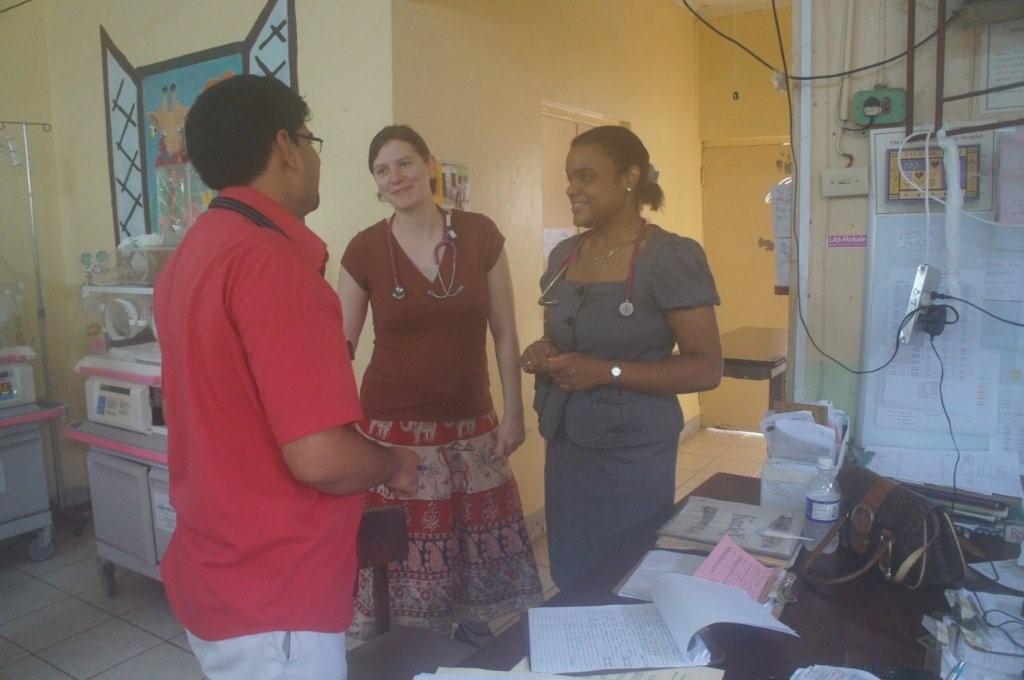2/21/12 Posted by Amy Westman, MD (a third year pediatric resident from Kaiser Permanente Oakland in…
Part 1 of Learning through doing and seeing
2/13/12
Posted by Amy Westman, MD (a third year pediatric resident from Kaiser Permanente Oakland in preparation for a global health elective in Ocho Rios, Jamaica with Issa Trust Foundation.
I spent a month in Jamaica, parish of St. Mary, working in several hospital clinics. It was hard coming from working in the American medical system to working in the Jamaican medical system, but it got easier everyday. I had the opportunity to see many patients and work with many wonderful physicians. Our goals as physicians both there in Jamaica and here in America are the same, to do what is best for our patients, we just get there in different ways sometimes.
My weeks began at Port Maria Hospital. The kids that generally showed up for regular clinic that day got funneled to me, or were sent from A&E (the ED), lots of general complaints. The first patient the A&E doc sent me was a consult to rule out leishmaniasis. What do I know about leishmaniasis? I work in California! So I said, “Give me a minute,” got out my atlas of tropical diseases, and read up quickly. Then I was able to say with some certainty that the child did not have leishmaniasis. But that’s how a lot of my experiences were, learning through doing and seeing. I saw the typical childhood problems that I see so often here at home: asthma, eczema, otitis, pharyngitis, and cellulitis. I also saw things that I have never seen before, but now have seen several times and feel confident in my diagnosis, such as miliaria crystallina. So many babies at their well checks seem to have developed it, and at first I wasn’t sure what I was seeing, but after looking it up on the internet (at night after clinic – no wifi or computers there) and seeing it over and over again, I can now confidently tell parents what it is and offer reassurance.
I am also visiting Annotto Bay Hospital in the middle of my weeks. There I see patients and participate in ward rounds, as well as being in the pediatric clinic where I see kids with problems that are followed by the pediatrician there, Dr. Ramos. More asthma, anemia, and some follow-ups post discharge from the hospital. On the inpatient side the majority of the patients I saw were neonates with suspected sepsis or risk factors. Since it is very difficult to get cultures here (they must be sent to Kingston and most of the time never make it there due to transportation problems or make it there too late to be useful for making treatment decisions), most babies with any suspicion, those who would be a 48 hours rule out in the states, get a full 5 day course of IV antibiotics and then are sent home on orals.
On Fridays I make the 2+ hour ride (thanks meclizine!) to Port Anotonio Hospital in the parish of Portland, where I visit the wards and then go to clinic. Here they do not have a pediatrician at all, but the general physicians round on the patients on the ward.
There were so many interesting cultural things to be learned as well. I quickly heard about black dressing, which is tar based, an all-purpose salve for infections and the like. It took me a while to figure out what the mothers were talking about when they said the baby had “coal” (not sure how they spell it!) in his emesis or diarrhea, but I realized they meant mucus. I asked my patient’s parents a lot of questions about things like this as you can learn so much from them about attitudes toward health and nutrition and home remedies used.
One thing I had to get used to there is that I am always “Dr. Westman,” not “Amy,” at least at the hospital. Here at Kaiser I am on a first name basis with everyone in my program, from interns to attendings and administrators. But in Jamaica, it is more formal. A doctor is always “Dr. . .” and a nurse is always “Nurse . . .” The other doctors and even the interns introduce themselves as “Dr . . .” and I’ve noticed that even when they drop the doctor part, others refer to them by their last name only.
Another thing that just goes with the territory here, and I presume for all global health rotations or missions, is that you just need to relax and go with the flow. Things are not as tightly regimented and scheduled there as in America, but everything gets taken care of in the end. The patients show up at 8am and register first come, first serve, but will wait all day to be seen, no appointment times. You, as a volunteer there, will always have someone to drive you to and from the hospitals and clinics, but it may not be the same person and they may not pick you up at the expected time. But you will get there and back safely! The doctors mentioned in the orientation packets may not be around, but there is always someone there to help with any questions. Even if there aren’t many clinic patients one day (my wide range has been from 2 to 30, but on average about 20), you can always find other ways to help out like seeing patients in A&E. Just go with the flow, and everything will work out. One of the big things I’ve learned in my time there!

This Post Has 0 Comments